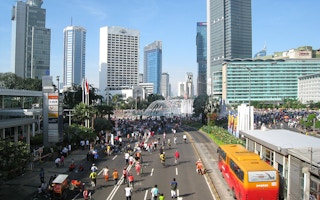As Houston, Miami, Mumbai and other communities clean up following Hurricanes Harvey and Irma and unusually relentless monsoons, a new report offers strategies for bolstering urban defences against climate change.
“Cities100: A guide to cities preparing for the next Harvey and Irma” profiles the authors’ choices for the “100 best urban solutions to climate change around the world.”
The publication and accompanying online database were released this week as new storms continued to devastate islands in the Caribbean. Meanwhile, power outages plague more than a million residents of Florida and Georgia a week after a ferocious hurricane devastated the US southeast.
Blunt predictions of worsening weather patterns are a motivation for cities to take preparatory steps now.
[See: Cities aren’t using their key tool for climate action: Urban planning]
The international think tank Sustainia collaborated on the new project for the third year in a row with C40, the megacities network focused on climate change, and Realdania, a Copenhagen-based philanthropy that supports the built environment.
The 2017 version highlights 100 innovative ideas from 73 cities in 29 countries. The report focuses on solutions in five areas: transportation, waste, energy, mitigation and adaptation.
“This year’s report shows how more cities than ever before are using climate action to future-proof against challenges such as extreme weather, air pollution and growing populations,” Sustainia says in a blog post.
Global city leaders rely on multiple techniques to adapt to the harsh new realities of climate change. Examples from the report include:
- Jakarta’s flood reduction: Nearly 80 per cent of public green space in congested Jakarta has been lost to development in the past 40 years. To reserve the trend and ease severe flooding, the Indonesian capital plans to build 3,000 child-friendly parks by 2022 in high-density areas. The green space could lessen the duration of floods by absorbing storm run-off.
[See: Why Copenhagen is building parks that can turn into ponds]
- New Orleans’s climate action: After being battered by Hurricane Katrina in 2005, the coastal US city of New Orleans hopes to reduce the frequency and strength of hurricanes by reducing emissions linked to climate change. Climate Action for a Resilient New Orleans, part of the office of Mayor Mitchell Landrieu, details 27 steps the city can take to halve fossil-fuel emissions by 2030.
- Quito prioritises urban nature: The capital of Ecuador — known for urban sprawl that criss-crosses mountains and valleys — strives to protect fragile ecosystems through municipal planning. This involves measuring deforestation and adapting endangered habitats to climatic shifts. The broader goal is to mitigate climate change through preservation of natural environments.
Strengthening flood and storm defenses does not always require costly expenditures and newfangled technologies. “By integrating nature into city infrastructure for better climate adaptation, cities can quantify the value of ecosystem services,” Sustainia says.
Another important takeaway: Smaller cities can be leaders on resilience. That’s because they are well-positioned to serve as test beds for ideas and innovations that can be scaled if proven successful.
[See: Transition time for chief resilience officers]
The authors emphasise that climate action can achieve a twofold function. Such initiatives can improve the quality of life in urban neighbourhoods most vulnerable to weather-related catastrophes, while also helping cities save money over the long term by reducing clean-up costs.
These urban profiles also highlight some creative financing models that municipalities can pursue to fund climate change-mitigation strategies. For example, residents of Suwon, South Korea, formed a cooperative to invest in solar technology and reinvested the profits in community endeavors.
For more information on ways to protect cities from changing weather patterns, visit www.cities100.com, an innovation hub with details about the 300 ideas featured in the Cities100 series. The results can be filtered by sectors such as energy and waste or “global goals” such as climate action and clean water.
This story was published with permission from Citiscope, a non-profit news outlet that covers innovations in cities. More at Citiscope.org










